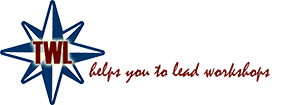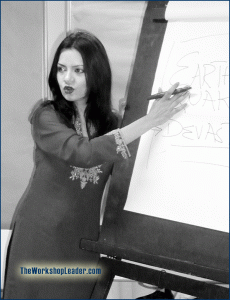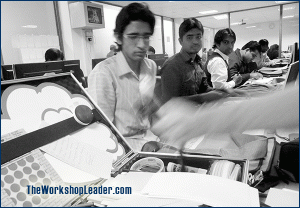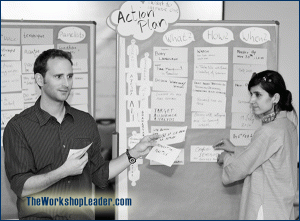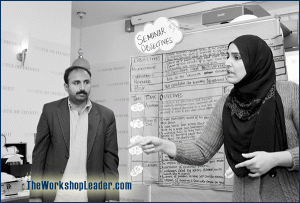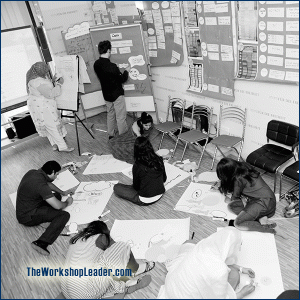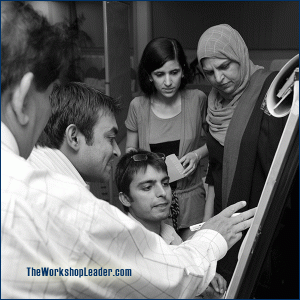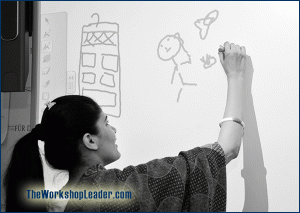Man is a tool-using animal. Without tools he is nothing, with tools he is all.
Thomas Carlyle (1795—1881)
Scottish philosopher and satirical writer
Have you ever seen a demonstration where people move through the streets with screens and laptops? Well, me neither. There are many good reasons to use traditional presentation tools. Banners, posters and white boards are not out-dated. Depending on the occasion and the purpose they might be the better choice:
- Extremely short presentations with focus on one or two issues.
- To accompany a permanent exhibition in a building (giving a presenting while walking with the group is a very nice alternative to more static alternatives by the way: nobody will be sleeping as walking stimulates the brain. It also offers more opportunities for interaction).
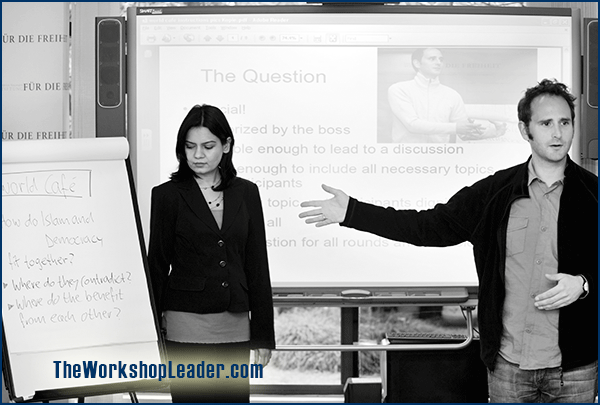
You can achieve a more personal or even emotional effect by staying away from electronic equipment. In addition, any electronic medium is liable to experience unexpected problems due to load shedding, crashed hard disks or corrupted files. So if you do choose to make your presentation using electronic media, it’s good to have back-up solutions:
- Have print versions of your most important graphs.
- Be flexible and develop the same content on a flip chart.
- Have a second laptop on standby in case the main one fails.
- Also make sure you can borrow a second data projector if necessary.
- Always have a spare bulb for your data projector.
Don’t underestimate the damage done to your data projector by load shedding. These special bulbs need to cool down properly and every immediate shutdown reduces their lifetime significantly. The bulbs are expensive (ca. USD 400) and hard to get. As such, it’s advisable in countries with irregularities in their power grid to have the data projector attached to an Uninterruptible Power Supply (UPS).
Additionally, it’s useful to give handouts on which you have compiled the most important facts. We recommend giving them out after your presentation, as participants will start to read and stop listening. Furthermore, it will reduce the possibility for surprises.
Nonetheless, electronic presentations offer some advantages:
- Brings together text, images, films and audio files in one medium.
- Cost-effectiveness (if you already have a computer and projector available).
Moderator Box
The moderator box or bag is your toolbox as moderator like a toolbox for a mechanic. Instead of screwdrivers and wrenches you’ll find markers and cards.
Suitcase, box or bag? That’s a question of personal preference. You can purchase complete sets already filled with all the necessary equipment for example at www.neuland.com in Germany. So far, we haven’t seen any of these pre-prepared moderator kits available in many other countries. But as you have learned to turn weaknesses into strengths, in those countries you have the advantage of having things produced according to your own wishes and at a much cheaper price.
The requirements are that a certain set of material (there is a complete list of suggested content in the Annex) should fit in. All of it must be easy and quickly accessible — without wasting time searching for it! Additionally, it should be convenient to transport without the material getting mixed up during journey.
Of course the suitcase must be checked before the workshop — not five minutes before but at least two days, which allows you to replace dried-out markers or glue sticks and refill the required number of cards.
Boards and Flip charts
Boards and flip charts are universal and practical tools for presentations. You can prepare sheets with different content, develop content step by step during the presentation or work with the participants.
Results can be attached to the walls of a seminar room. While data projectors usually only show one screen, with boards and flip charts you can suddenly have a multitude of ‘screens’. You can ‘walk the talk’, i.e. — walking from one sheet to another. This is much less tiring for participants than gazing all the time at the same screen.
Like suitcases, boards are not available to buy in Pakistan. So far, we haven’t found anyone who is able to produce foldable, lightweight aluminium boards. We would be delighted for any tips on where to get them! So far, we have had to import them from Germany. Different shops offer a variety of boards, e.g. Neuland.com.
The requirements are that they are light, foldable and easy to transport. You should be able to stick cards and papers to them with pins. A bag protects the boards from dirt and weather.
The boards can be used for multiple purposes, e.g. the Metaplan® technique, for display of poster or just simply as separators.
Principles of working
Writing on a flip chart or board is dangerous for the moderator, as he might lose the group. If you turn your back to the participants and they can’t see what’s happening, they will start to discuss private issues, lose interest or do other things. The better you are prepared the less this will happen. What you need in writing should be mainly written before the workshop. You just take the prepared cards or flip the paper. Otherwise keep participants busy.
In order to enable the focus of participants, they need orientation to structure new content. You need headings, sub-headings and single points to present the content in a structured way. The less clear you are about the structure, the more participants will be confused.
There are two ways to develop the content (compare also Chapter Communication>Rhetoric): induction or deduction. This means that either you start from the detail and enlarge step by step to the overall topic or you begin with the generalisation and work towards the details. The method you choose depends on the content and your audience. But the way should be clear to everyone.
Pre-pinning is a useful way of saving time as well as creating curiosity. To do this you should initially have the cards facing the board. As you progress topic to topic, you turn them over. Participants will be able to see that there is more content coming and automatically, they won’t spend too much time discussing one single card — knowing that this will delay the break…
Slitting is another way to create curiosity and to be quick. Stick an additional piece of brown paper, in which you have cut some slits, over the board. Under the paper, but partially visible through these slits, you place your pre-prepared cards. At the given moment, you pull a card out and pin it on the board visibly. It is especially useful to arrange the slits according to a certain structure or order.
Headings give us orientation. They are essential for participants to be able to focus on the content — as they know where to put the new stuff in their brain. But headings have also the task of piquing the interest and making the audience curious. Good headings are the icing on the cake made out of good content.
Tactics
In presentations, we can borrow a few tactics from the tabloid press. Use verbs or action words instead of nouns!
Direct speech
- Proverbs
- Emotions
- Questions
- Metaphors
- Humour
You should make full use of eye-catching question and exclamation marks. Underline your text; use red and unusually shaped cards. Try it and you will be pleased by the feedback you receive.
Linking is an alternative to clustering if you want to work out a sequence with your participants. In this technique you have several cards pinned on the board. You will take a small string and pin it from card to card in the sequence you would like. The starting point requires a little loop, while the end could just hang down.
For colouring bigger surfaces it’s better to use a crayon. You will still be able to read marker text and lines. You can achieve nice effects with two different colours. Using marker to fill empty space takes more time and you will see individual lines as well. Crayon is not recommended for writing, as the contrast is not high enough. Pastel is not that useful as its pigment powder will partially fall down and you will also get it on your hand.
For a nice change, you could also use crayon hatching instead of bullet points or underlining important words with crayon.
If you misspell a word on your flip chart don’t cross it out and don’t try to add a letter. It’ll end up looking even worse. And starting the whole flip chart from scratch would take too much time. Instead, cut out a piece of flip chart paper, glue it over the top and just write the word or line again. Before the workshop starts it’s useful to have a few flip chart papers cut out for this purpose.
Other ideas for flip charts depend on your creativity. In order to inspire your brain here are some starters:
Creative shapes: Create your own cards in whatever shapes you want — a pair of scissors will do the trick.
Pin a box: The board is a public place: glue or stick a box on the board for voting cards. Then, let the participant cast voting cards on a given topic.
Flipping the board: If you have more content than you have space available on the board, you can turn a board into a huge flip chart. For this you will need to pin several pieces of brown paper on top of each other and just flip them over.
The door: If the aim is to convey one or several central key words, you could create a ‘Door’ in your flip chart or board paper. For this, you cut a door in the top sheet of paper, which you can open to reveal the keyword(s) on the paper below. This technique could also be used for solutions, e.g. during a quiz, or for suggestions.
Feedback: Instead of verbal feedback on performance, you could ask participants to write feedback on cards. This is especially useful when you cluster content, process and personal goals [see Moderation]. Often participants are more honest if they write rather than give feedback face-to-face. Furthermore, if you get written feedback, you can keep it as a record for later.
Graffiti: Looking at some cities you get the impression that graffiti is an artistic way to express your opinion — often more open than any other form. You could — instead of brainstorming — use one or two boards as graffiti boards on which everybody is invited to write, paint, sketch whatever comes into his/her mind. This might give the moderator an insight into the state of mind and level of energy of the group. During wartime the graffitied walls of latrines tend to be the best and most honest mirror of soldiers’ souls.
Constellations of participants are an interesting way of visualising the relationship of the participants to the topic. Participants position themselves in a room at a distance from one or several topics or statements. This can provoke interesting discussions — and gets people out of their seats. For this, place one to four boards with topics written on them in the room and ask the participants to stand as close as they feel to the given statements. During the discussion they should move according to their change of opinion.
Flip charts
Flip charts are available in a variety of types — stand alone or rolling. In the best case they are adjustable in height. Flip chart paper with holes (which fit the respective hooks on the board) is more stable than the kind that work with clips. Aluminium versions are lighter and easier to transport.
For the moderation of business meetings a flip chart might be sufficient. However, you can use this training tool in many more ways that you might think of.
Whiteboard
Often you find whiteboards in seminar venues or schools. They offer a free space for writing and developing topics. But I have to admit that I am not a big fan of whiteboards: you can’t use the Metaplan® technique nor can you flip written papers to save the content to return to later. Instead, you have to wipe out the content as soon as the board is filled. Thus, we only use them when there is no alternative.
Electronic Whiteboards
Electronic whiteboards, also known by the company name SMART Board™, are an all encompassing tool: It’s a white board including multimedia, sound and the possibility to write on it with your finger or a marker (without ink). You can save your work, print it, mail it etc. The software triggers the most interactive learning. Consequently, it is the most flexible, most efficient and most multi-purpose tool we have.
On the other hand, these SMART Boards™ are very expensive and not easy to move to different workshop venues. Unfortunately, also these electronic whiteboards are not available in everywhere.
Tools & Toys
For different moderation techniques and games we need different tools and toys. If you try new games make sure that you have the right equipment with you. For the techniques in this book you should have:
Softball for all kinds of energisers or games.
Clothesline and clothes pegs for hanging cards and posters up. You can bind them or use a hammer and a nail.
Balloons for energisers or leadership games.
Data Projector
The data projector is a modern multi-purpose tool. But again it is not the one doing the presentation. You are the presenter and although you are using technology, you cannot rely on it too heavily. The advantage of a data projector is that you can combine text, image, illustration, animation, audio files and videos. This is a wonderful opportunity! Use it wisely!
There are a huge variety of data projectors in the market. The differences lie in:
- Technology: Bulb or LED
- Luminosity: Measured in lumen
- Lenses: Focal distance, fixed lenses or zoom
- Noise
- Size and Weight
Make sure that it suits your needs. It is especially important to ensure that the lense and luminosity are suitable for your room. It wouldn’t make sense to have a powerful projector for a small room, because the distance will be not enough. Nor does it make sense to have a weak projector in a room, which can’t be darkened and will be full of daylight during the presentation. Whether you can compete with the noise of a projector is again a question of personal preference.
The same goes for size and weight. Are you willing to carry a huge and heavy model? Of course we have to balance our decision with the price.
Most laptops have keys with symbols of a monitor. By pressing it you can change the settings in order to switch computer’s output to the data projector.
